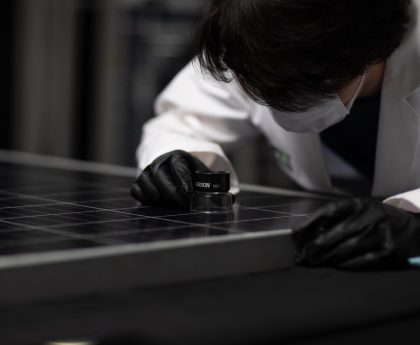This innovative company revolutionizes the market by offering solar panels that are easily and practically integrated into your home, providing an accessible and efficient solution to take advantage of solar energy in an unprecedented way. With this proposal, they seek to simplify the adoption of renewable energy, marking a milestone in efficiency and accessibility in residential solar energy generation.
A long list of benefits for solar power panel manufacturing
Imagine the convenience of having solar panels integrated internally into your home, energy to directly power your technology devices. This vision redefines the way we harness solar energy, offering a practical and efficient solution that is perfectly suited to modern needs.
Solar technology pioneer Solaires Entreprises has taken a significant step by initiating pilot production of photovoltaic modules designed specifically for indoors. This milestone is taking place in Langford, in the Canadian province of British Columbia, marking a crucial step forward in realizing the vision of clean and efficient energy directly from inside homes.
According to a recent statement by Fabian De La Fuente, CEO of Solaires to PV Magazine, they are currently looking to offer these perovskite solar panels to companies manufacturing vehicles, LED components, sensors and consumer electronics, making it clear that: “The pilot line will produce 200,000 units per year, each measuring 3.82 cm x 7.62 cm”.
How do these new and improved perovskite photovoltaic panels work?
Perovskite, characterized by its crystalline structure and flexibility, has emerged as a key material in solar energy innovation. The combination of perovskite and crystalline silicon in photovoltaic cells not only provides an efficient and flexible structure, but also acts as a semiconductor, a crucial ability to absorb sunlight and efficiently convert it into usable energy.
As for De La Fuente, he highlights the superiority of thin-film technologies, with an emphasis on perovskites, in absorbing light in indoor environments compared to silicon. This distinction is attributed to the undeniable properties of perovskites as a material, with an exceptional ability to capture light in indoor lighting conditions.
A common question that can arise is about the effectiveness of these solar panels, as there are doubts about their ability to have a limited dose of sunlight when indoors. This is where perovskite takes the lead once again, as this material is highly effective, outperforming traditional solar panels by 35%, which would translate into a highly effective energy yield indoors.
How and where will perovskite solar modules be manufactured?
In the same vein, the CEO went on to reveal that the materials for the construction of these panels are readily available on the market: “We have all the equipment to do it. Our manufacturing process is a sheet-to-sheet process for rigid glass substrates using die coating, silk screening, laser ablation and lamination. We also have in-house quality control and testing equipment.”
Modules using tuned perovskite for indoor light absorption stand out for their efficiency, achieving a remarkable 35% energy conversion under indoor lighting conditions. Current prototypes exhibit an aperture area of 17.22 cm2, with an active area of 14.70 cm2, indicating a promising approach for applications that harness energy in indoor environments.
Finally, Solaires plans not only to manufacture modules, but also to continue commercializing perovskite materials. Its business approach involves licensing technology to global manufacturers, providing not only the modules, but also supplying key materials such as its perovskite ink and other unique layers in the complete package.
This post was originally published on 3rd party site mentioned in the title of this site





